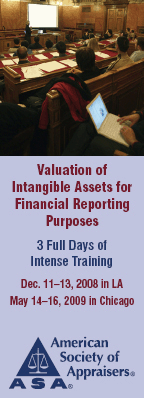
| Bankers seek action on fair value before year-end In a letter penned to Treasury Secretary Henry Paulson Jr., American Bankers Association president Edward Yingling notes that, “delay in addressing the failures of the mark-to-market mechanisms in fair value reporting will undo much of the work of Treasury’s Capital Repurchase Program.” Yingling’s suggested remedies, “which do not require a wholesale reworking of mark-to-market,” are:
According to Yingling, “these changes will actually improve financial reporting for users of financial institutions’ financial statements, as the current illiquid values required to be reported have a significant downward bias, which results in overstating losses.” The letter was simultaneously sent to the SEC, the Federal Reserve, incoming Treasury Secretary Timothy Geithner, and Democrat and Republican leaders of the House Financial Services Committee and the Senate Banking Committee. Need help sorting out USPAP and other BV standards? The November 10 deadline for written comments to the Appraisal Standards Board (ASB) on proposed edits relating to the upcoming 2010-2011 edition of the Uniform Standards of Professional Appraisal Practice (USPAP) has passed. The ASB will issue a Second Exposure Draft that incorporates changes and responds to issues raised in public comments to the First Exposure Draft this month, according to a memorandum issued by ASB chair, Sandra Guilfoil. Under consideration are proposed edits relating to: Definition of Signature; Definition of Jurisdictional Exception and the JURISDICTIONAL EXCEPTION RULE; The ETHICS RULE; The COMPETENCY RULE; and STANDARD 3, Appraisal Review, Development and Reporting. In the interim, however, appraisers can still gain insights on current USPAP implementation and application from the 2008-2009 USPAP + Guidance. But how do these standards complement or possibly conflict with the professional business valuation standards that are promulgated by the American Institute of Certified Public Accountants; the American Society of Appraisers; the Institute of Business Appraisers; the National Association of Certified Valuation Analysts; and Internal Revenue Service, which released its “IRM 4.48, Engineering Program, Business Valuation Guidelines” in July 2006? To assist BV experts in navigating the various standards and updates, we enlisted the help of BV experts David Anderson, ASA and Donald Wisehart, CPA/ABV, ASA, MST. The result: A one-of-a-kind table detailing “Permitted Engagements and Reports” and a “Comparative Chart of BV Report Writing Standards,” which identifies the written report type that each promulgating organization permits and details the reporting disclosures and requirements of each. Best of all, you can access a Free Download of Wisehart and Anderson’s findings, which appear with the author’s expanded commentary in the December 2008 Business Valuation Update™. Expert views on private business valuation & the financial crisis Robert T. Slee, CBA, of Robertson & Foley, will keynote the Russian Society of Appraisers annual Congress in Moscow on December 10. The topic: The impact of the current financial crisis on private business valuation. We caught up with Slee and got an exclusive overview of his five most important takeaways for all BV experts:
Projection Inspection: Distinguishing fact from fiction when working with management If you missed our popular one-day workshop on management projections held last August in Lake Tahoe, be sure to check out this week’s teleconference The Uses and Abuses of Management Projections, featuring Grant Thornton’s Neil Beaton, CPA/ABV, CFA, ASA and Stuart Weiss, CPA/ABV. The session includes recorded highlights from the Tahoe workshop – plus Beaton will walk through a case study (spreadsheet will be provided to registrants in advance) live on the call. The case study is aimed at helping attendees identify and avoid the pitfalls associated with projections. Names will be changed to protect the innocent, but the case exemplifies the uncertainty inherent in management projections – as in recent economic events. Attendees will pick up key insights and will have the chance to interact directly with Neil during Q&A at the end. But there is an added benefit: Registrants can choose to utilize an optional webinar platform. Do not miss this unique session taking place this Thursday at 10 a.m. PT/1 p.m. ET; register here. This case may mark the start of the predicted securities litigation boom In what may be the first reported case to emerge from the ongoing financial crisis, the North Carolina Superior Court considered a shareholder’s challenge to the proposed merger between Wachovia and Wells Fargo banks. In Ehrenhaus v. Baker (Nov. 3, 2008), a Wachovia shareholder claims that the merger price and other particulars of the deal are unfair, constituting a breach of the directors’ fiduciary duties. In particular, the merger permits:
In considering the plaintiff’s motion to enjoin the merger and expedite discovery, the court began with a dire assessment of the current U.S. economy:
Although the court denied the plaintiff’s request for speedy discovery, under the circumstances it did agree to expedite the injunction proceedings, asking the parties to file briefs in time for a November 24, 2008 hearing. Look for a complete abstract of the court’s decision in the January 2009 Business Valuation Update™, and additional reports of case proceedings in the BVWire™. Kudos to BV experts honored for volunteerism The Wire extends congratulations to Jay Fishman, FASA, CBA; James Rigby, Jr., ASA; and Linda Trugman, CPA/ABV, MCBA, ASA, MBA. The three received special honors and recognition of their volunteer service and willingness to give back to the BV discipline and the valuation profession at the recent ASA/American Institute of Certified Public Accountants (AICPA) Joint Business Valuation conference in Las Vegas. Fishman, with Financial Research Associates in Bala Cynwyd, Pennsylvania and a Fellow of the ASA, garnered the ASA Business Valuation Committee’s Lifetime Volunteer Service Award. Rigby—with Financial Valuation Group in Los Angeles—received the 2008 Volunteer of the Year from the ASA Business Valuation Committee. And Trugman—of Trugman Valuation Associates Inc. in Plantation, Florida—received the 2008 American Institute of Certified Public Accountants (AICPA) Volunteer of the Year Award. |
To ensure this email is delivered to your inbox,
please add editor@bvwire.com to your e-mail address book.
We respect your online time and privacy and pledge not to abuse this medium. To unsubscribe to BVWire™ reply to this e-mail with 'REMOVE BVWire' in the subject line or click here.
Copyright © 2008 by Business Valuation Resources, LLC
BVWire™ (ISSN 1933-9364) is published weekly by Business Valuation Resources, LLC
Editorial Staff | Advertise in the BVWire | Copyright Notice
|
|



